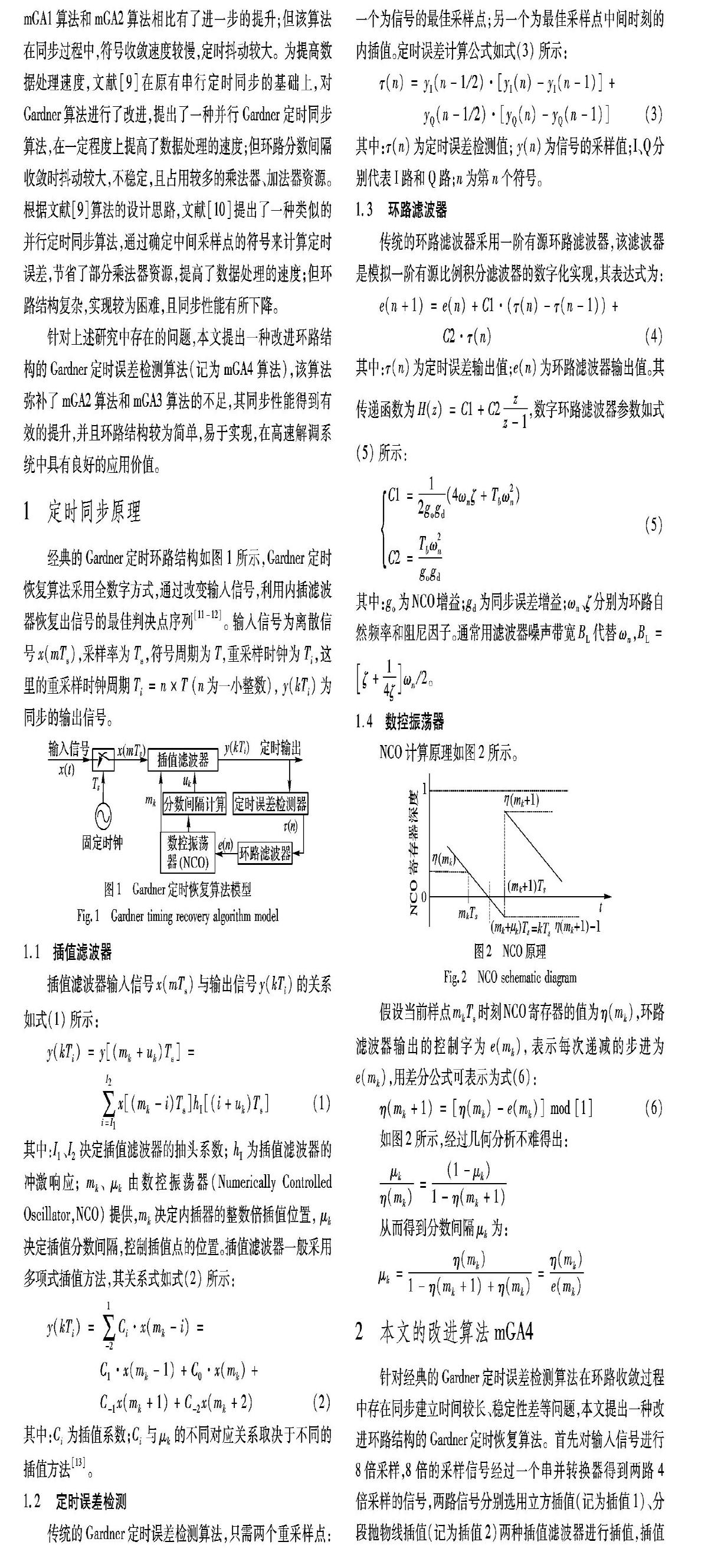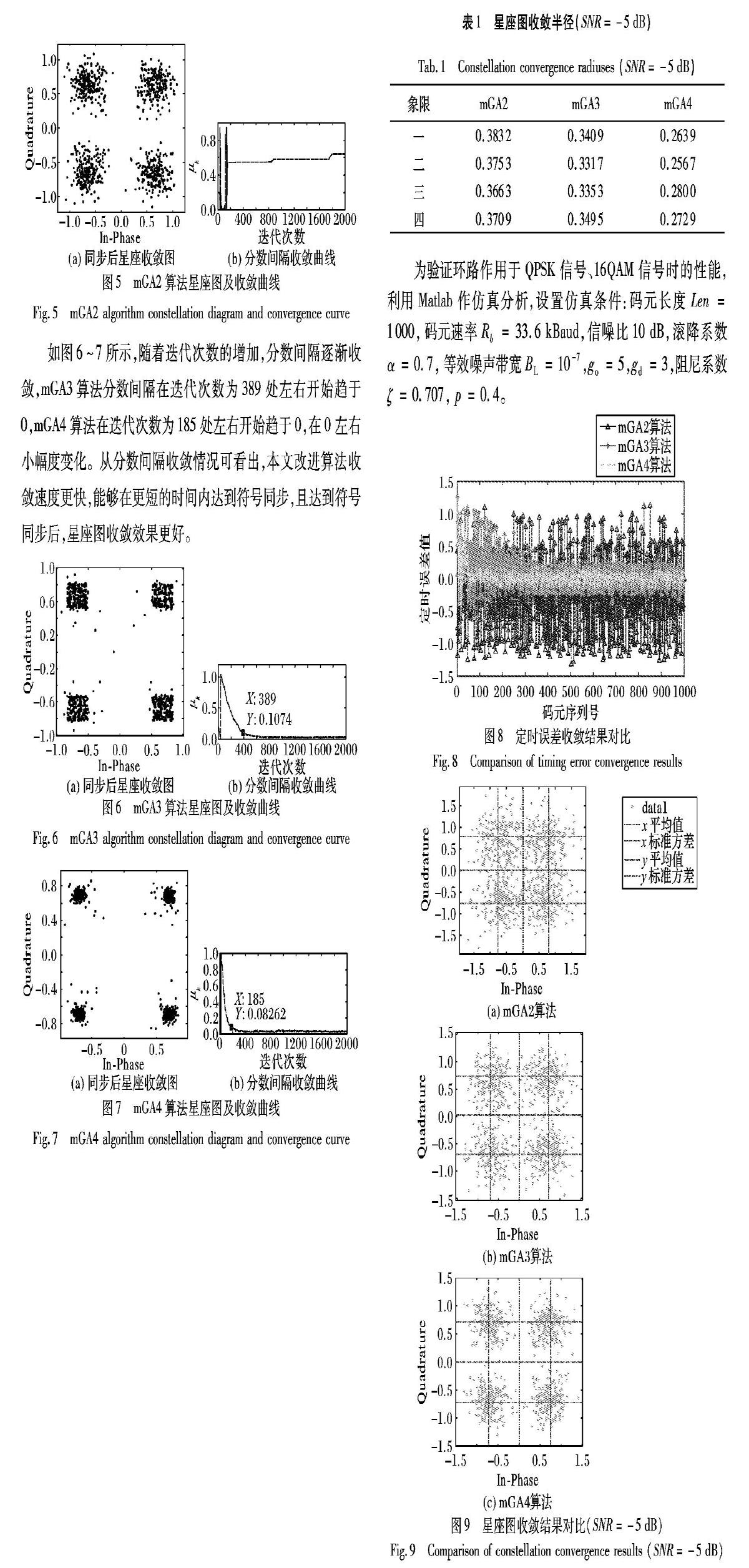改进环路结构的Gardner定时恢复算法
2019-11-15李维江虹伍春邓皓文
李维 江虹 伍春 邓皓文



摘 要:针对经典的Gardner定时恢复算法存在同步建立时间长、同步稳定性能差等问题,提出一种改进环路结构的Gardner定时同步恢复算法。首先,该算法选用立方插值和分段抛物线插值两种插值滤波器进行插值,得到两路最佳插值序列;其次,分别计算两路插值序列对应的定时误差并求加权平均值,得到环路的定时误差;最后,以两路最佳插值序列的加权平均值作为环路输出。针对正交相移键控(QPSK)、正交幅度调制(16QAM)两种调制信号进行了仿真验证。仿真结果表明,该改进算法作用于QPSK信号时同步稳定性更好,相比作用于16QAM信号,其环路开始同步时码元的位置对应的序列数明显减小;并且该算法在信噪比为-5dB的情况下使QPSK信号星座图收敛半径为0.26左右,与类似锁频锁相(FPLL)的改进Gardner定时恢复算法相比收敛半径减小约0.08,该算法有效地缩短了同步建立的时间,提高了环路的稳定性,可广泛应用于高速解调系统。
关键词:位同步环路结构;改进型Gardner算法;加权平均;同步建立时间;同步性能
中图分类号:TN911.7
文献标志码:A
Abstract: Aiming at the problems of long synchronization setup time and poor synchronization stability in classical Gardner timing recovery algorithms, a Gardner timing synchronization recovery algorithm with improved loop structure was proposed. Firstly, two interpolation filters with cubic interpolation and piece wise parabolic interpolation were used to obtain two optimal interpolation sequences. Secondly, the timing errors corresponding to the two interpolation sequences were calculated respectively and the weighted average value was obtained to gain the timing error of the loop. Finally, the weighted average value of two optimal interpolation sequences was used as the loop output. The simulation experiments of two modulated signals of Quadrature Phase Shift Keying (QPSK) and 16 Quadrature Amplitude Modulation (16QAM) were performed. Simulation results show that the synchronization stability of the proposed algorithm is better on QPSK signal. Compared with performing on 16QAM signal, the number of sequences corresponding to the position of the symbols when the loop starts the synchronization is obviously reduced. Additionally by using the propposed algorithm, the convergence radius of the QPSK constellation is about 0.26 when the SNR is -5dB. Compared with the improved Gardner timing recovery algorithm similar to Frequency and Phase Lock Loop (FPLL), the convergence radius is reduced by 0.08. This algorithm effectively shortens the synchronization setup time, improves the stability of the loop, and can be widely applied in high-speed demodulation system.
Key words: bit synchronization loop structure; improved Gardner algorithm; weighted average; synchronization setup time; synchronization performance
0 引言
定時恢复是数字解调技术中的关键环节,对解调系统的性能有着重要的影响[1-2]。早期的Gardner定时同步算法能够较好地解决接收端接收到的信号与本地时钟信号不一致的问题,但存在同步建立时间长、稳定性较差等缺陷,其环路性能难以满足当前高速解调系统的需要[3-4]。随着数字解调技术的快速发展,同步建立时间短、环路稳定性高的定时恢复算法成为一项迫切需求[5]。
为此,文献[6]利用相邻码元符号相同时,对误差检测器检测出的误差进行取反,得出了一种改进的Gardner算法,记为改进的Gardner定时恢复算法1(modified Gardner timing recovery Algorithm 1,mGA1);文献[7]对mGA1算法进行了改进(记为mGA2算法),降低了算法复杂度。上述两种方法在一定程度上提高了符号同步的性能,但仍然存在算法复杂度高、硬件资源消耗大、环路稳定性较差等问题。为克服上述方法的不足,文献[8]提出了一种类似锁频锁相(Frequency and Phase Lock Loop, FPLL)的改进Gardner定时恢复算法(记为mGA3算法),其同步性能与mGA1算法和mGA2算法相比有了进一步的提升;但该算法在同步过程中,符号收敛速度较慢,定时抖动较大。为提高数据处理速度,文献[9]在原有串行定时同步的基础上,对Gardner算法进行了改进,提出了一种并行Gardner定时同步算法,在一定程度上提高了数据处理的速度;但环路分数间隔收敛时抖动较大,不稳定,且占用较多的乘法器、加法器资源。根据文献[9]算法的设计思路,文献[10]提出了一种类似的并行定时同步算法,通过确定中间采样点的符号来计算定时误差,节省了部分乘法器资源,提高了数据处理的速度;但环路结构复杂,实现较为困难,且同步性能有所下降。
4 结语
本文在研究Gardner定时同步算法原理的基础上,为了解决传统的Gardner定时同步算法及经典改进算法存在建立同步时间长、同步稳定性能差等问题,提出一种改进环路结构的Gardner定时同步算法。仿真结果表明,本文改进算法优于经典的Gardner定时恢复算法及已有改进算法,对于QPSK、16QAM信号,环路作用于QPSK时,稳定性更好,解调性能更佳;该算法使用两路并行插值计算可能会占用更多的内存资源,但在一定程度上提高了同步性能,缩短同步建立的时间,具有良好的可实现性和应用价值。
参考文献(References)
[1] 付永明, 朱江, 琚瑛珏. Gardner 定时同步环路参数设计及性能分析[J]. 通信学报, 2012, 33(6): 191-198. (FU Y M, ZHU J, JU Y J. Parameters design and performance analysis of the timing recovery loop based on Gardner timing detector[J]. Journal on Communications, 2012, 33(6): 191-198.)
[2] 王磊, 隋强, 杜昌澔, 等. 自噪声抑制Gardner算法及位同步环路设计[J]. 红外与激光工程, 2017, 46(6): 187-192. (WANG L, SUI Q, DU C H, et al. Self-noise abatement Gardner algorithm and bit synchronous loop design[J]. Infrared and Laser Engineering, 2017, 46(6): 187-192.)
[3] 肖磊. 并行高速通信解调系统中同步技术的研究与实现[D]. 成都: 电子科技大学, 2017: 28-45. (XIAO L. Study and implementation of synchronization for parallel high data rate demodulation system[D]. Chengdu: University of Electronic Science and Technology of China, 2017: 28-45.)
[4] GARDNER F M. A BPSK/QPSK timing-error detector for sampled receivers[J]. IEEE Transactions on Communications, 1986, 34(5): 423-429.
[5] 崔龙斌. QAM解调数据并行处理定时同步技术研究[D]. 成都: 电子科技大学, 2018: 9-39. (CUI L B. Research on parallel timing synchronization technology in QAM demodulation data[D]. Chengdu: University of Electronic Science and Technology of China, 2018: 9-39.)
[6] LIM D. A modified Gardner detector for symbol timing recovery of M-PSK Signals[J]. IEEE Transactions on Communications, 2004, 52(10): 1643-1647.
[7] YANG D W, YAN C X, WANG H, et al. Extension to Gardner timing error detector for QPSK signals[C]// Proceedings of International Conference on Wireless Communications and Signal Processing. Piscataway: IEEE, 2010: 1-5.
[8] 刘伟, 姚远程, 秦明伟. 一种改进的Gardner定时同步算法[J]. 计算机工程, 2013, 39(11): 299-302. (LIU W, YAO Y C, QIN M W. An improved Gardner timing synchronization algorithm[J]. Computer Engineering, 2013, 39(11): 299-302.)
[9] LI H, WANG Z, WANG H. A high speed parallel timing synchronization algorithm for 16QAM[C]// Proceedings of the 13th International Computer Conference on Wavelet Active Media Technology and Information Processing. Piscataway: IEEE, 2016: 403-407.
[10] HU J, ZHU L, WANG J. The implementation of high speed parallel timing synchronization algorithm based on FPGA[C]// Proceedings of the 10th International Conference on Communication Software and Networks. Piscataway: IEEE, 2018: 484-487.
[11] 吴凤辉. 高阶QAM解调中的同步算法研究[D]. 哈尔滨: 哈尔滨工业大学, 2016: 10-51. (WU F H. Research on synchronization algorithms for high order QAM demodulation[D]. Harbin: Harbin Institute of Technology, 2016: 10-51.)
[12] LENG W M, ZHANG Y, YANG Z X. A modified Gardner detector for multilevel PAM/QAM system[C]// Proceedings of the 2008 International Conference on Communications, Circuits and Systems. Piscataway: IEEE, 2008: 891-895.
[13] ERUP L, GARDNER F M, HARRIS R A. Interpolation in digital modems. II. implementation and performance[J]. IEEE Transactions on Communications, 1993, 41(6): 998-1008.
[14] 王星泉. 一種改进型APSK盲定时同步误差估算法[J]. 科学技术与工程, 2015, 15(10): 195-196. (WANG X Q. A modified blind timing error estimation algorithm for APSK[J]. Science Technology and Engineering, 2015, 15(10): 195-196.)
